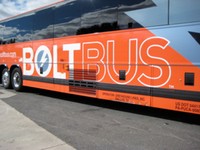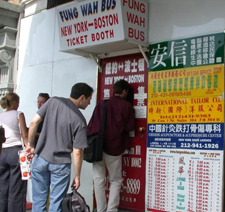Rutgers study: low-cost, curbside pickups revive intercity bus travel, pose policy questions

That trend, however, is reversing. Over the last decade there has been significant growth in low-cost, curbside bus lines that eschew terminals in favor of picking up and dropping off passengers on city street corners. Accompanying those changes are important policy questions about the public's safety and health.
Intercity bus travel is in the midst of a "remarkable transformation," says Nicholas J. Klein, a doctoral student at Rutgers’ Edward J. Bloustein School of Planning and Public Policy. His recent study, “The Impacts of Low-Cost Buses on the Transit Industry,” was conducted under the Rutgers Transportation Coordinating Council/Federal Transit Administration Research Program.
Curbside bus service got its start in the industry's 1990s deregulated environment when community-based operators started up lines to transport riders between Chinatowns in New York, Boston, Philadelphia, and Washington. It didn't take long for the low-cost mode of transportation to catch on beyond immigrant communities, and today curbside companies, both the Chinatown model and corporate-owned lines, such as Bolt Bus and Megabus, are the dominant choice for intercity bus travel on the Northeast Corridor.

Corridor ridership has doubled to more than 7 million passengers since their operations began in the late 1990s. Concurrently, market share for the traditional companies, such as Greyhound and Peter Pan, has fallen from 100 percent to 46 percent.
For his study, Klein recruited focus group participants from curbside bus stops in New York and Philadelphia to better understand ridership and travel behavior. One focus group was conducted in the Chinese Mandarin dialect. Passenger surveys were also handed out at stops in both cities.
Klein discovered differences between the curbside bus lines. He found Chinatown buses operate in a "gray area": some follow government regulations, while others appear to operate more informally. Most tickets are sold via flat-fare onboard cash transactions, or in storefronts near stops. Many buses are older and unmarked, making ownership and operating condition difficult to determine. Corporate curbside buses, on the other hand, are generally newer, branded vehicles and sell advance-purchase tickets though Internet-based, credit card transactions. They offer such amenities as on-board wireless Internet and power outlets for personal electronics.
When they began operations, Chinatown buses were cheaper than corporate buses, but that is no longer the case, Klein said. Corporate buses can offer variable pricing with advance-purchase discounts. Responding to the competition, even traditional buses companies have lowered fares and offer some amenities. The three bus types remain cheaper options than intercity rail (Amtrak) or air travel.
Overall, Klein found that intercity bus travel is growing because curbside buses offer better service and a new image of travel. He said those surveyed held an "overwhelmingly negative" view of traditional buses, often linked to the bus terminal's environment and patrons, in other words, the "experiential and emotional" aspects of travel. The bus line patrons' choice was strongly influenced by four factors: price, scheduling, location, and amenities, Klein said. While passengers are aware of safety issues, the most common being unsafe driving, so far, operational advantages of curbside buses have won out over safety concerns. Media coverage of Chinatown bus crashes and fires the past 10 years, however, might lead to bias against curbside buses, Klein says.
Other findings of the study:
- Participants switched to curbside buses from Amtrak to save money. Those who switched from commuter rail (NJ Transit or SEPTA) did so because those modes of transit had become "old school" and curbside buses were quicker, cheaper and did not require a transfer.
- The stereotype that intercity bus passengers are mostly poor people, women, and minorities is no longer the case, if it ever was. Chinatown bus passengers are predominantly male and Asian. Corporate curbside bus patrons are mostly white and more affluent than on other buses. Differing demographics raise questions about whether a tiered system of intercity buses is emerging on the Northeast Corridor.
- After using curbside buses, the data suggest passengers are less likely to use rail modes but are no less likely to drive.
- The emergence of curbside bus services has raised concerns over regulation of their operations. This finding could mean that problems associated with intercity buses may be caused by a lack of investment in maintenance and operations.
- At the local level, the use of city streets as informal bus depots has raised concerns about the impact on pedestrian safety, pollution from buses, and traffic congestion.
"As this industry continues to expand, the question of how the negative impacts of curbside buses can be regulated, while retaining the benefits for passengers, becomes more pressing,” Klein says.
Media Contact: Steve Manas
732-932-7084, ext. 612
E-mail: smanas@ur.rutgers.edu